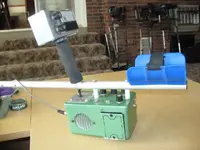klever 1983, despite all the praises you might read about this machine, just know that it's "niche" is very limited. It's depth is far outdone by today's machines. (5" or so max on a coin, perhaps 6" or 7" if you're in very ideal conditions and chasing whispers). It had no other form of disc. aside from nulling over small iron (so everything from a foil wad to a silver dollar all 'sound the same'). It was a bear to keep balanced over un-even ground. It didn't work well in minerals.
So you might be wondering "gee, why would anyone want that dinasour?". Answer: because it effortlessly saw through small iron on top of conductive targets. For example: You can group 2 or 3 nails on top of a coin, and the standard modern detector would "null" (ie: mask) over such a mess right? However, the 77b would give a beep for the coin under the nails. Yet when you pull out the coin from under the nails, the nails themselves go silent and don't give a signal. Thus it made for a good ghost town machines where small iron abounds.
but larger iron (cast iron stove parks, horse shoes, RR spikes, etc... ) sized stuff would come through. But with some practice, you could learn to tell those apart from conductive targets.





